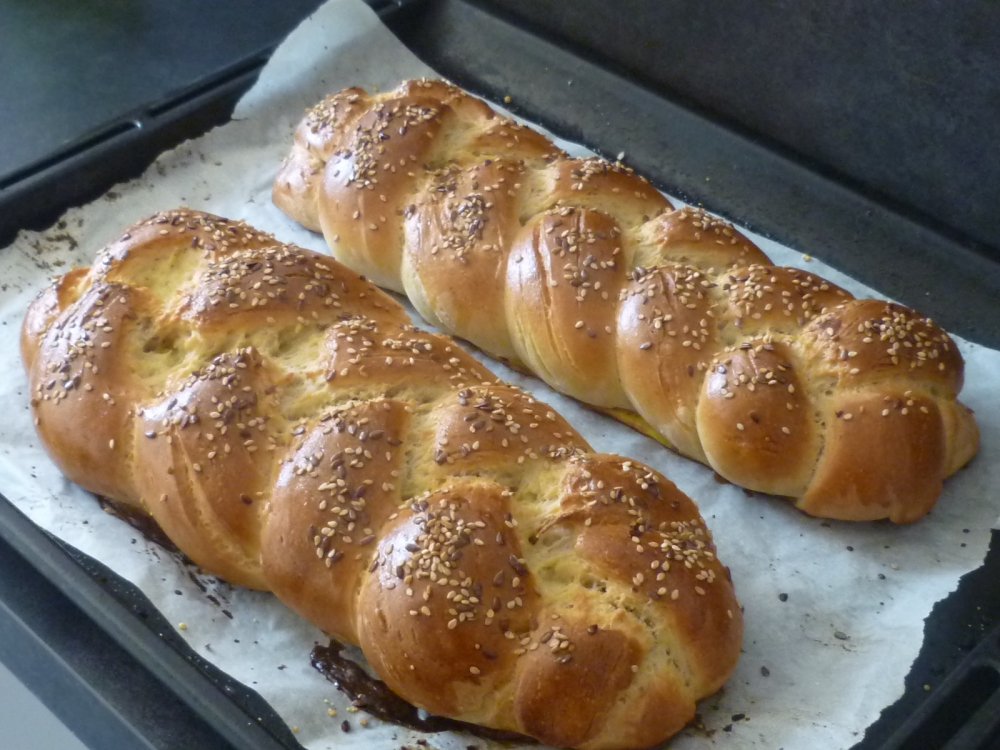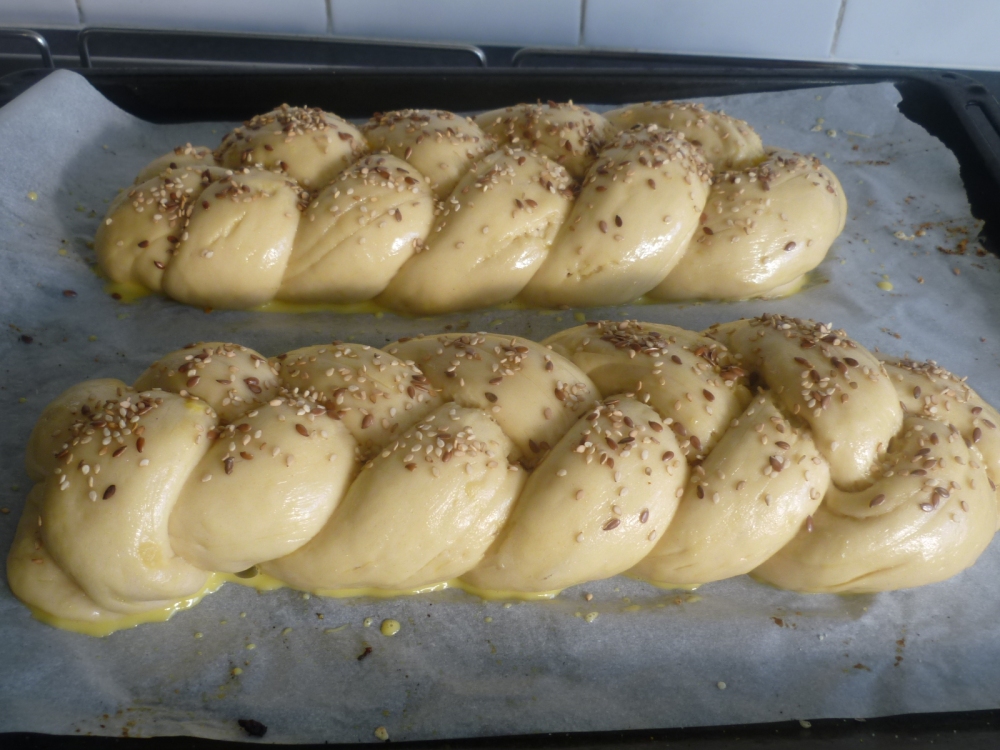The Challah bread that we traditionally bake for Shabbath can totally make for any other day’s bread, and in my humble opinion it is especially nice for a weekend brunch or simple breakfast. The texture of this bread is a lot like a brioche. It contains less butter and sugar though, and for that matter it can easily be eaten along with both savory or sweet food items.

For Friday night’s shabbath dinner, at home we like our challah with a nice hummus, egg salad, tchoutchouka (North-African bell peppers cooked salad), Israeli salad, or any other small entree. And then we remember that the main course is coming, and we’re stuffed already – because this bread is so good, and it is almost impossible to stop munching on it at all. lol. Usually, when Saturday comes, we enjoy eating challah for breakfast two ways. Either with a slice of chicken or turkey breast and butter (or cheese), or with butter and jam. Now when Sunday comes, and only in the case that we still got some challah leftovers (which rarely is the case I must say), I like to use them to make croutons for a Caesar salad that I’d prepare for lunch or dinner. So, as you can see, challah bread can be very versatile! Making it requires quite some effort, I must admit, but it really pays back, and the reward is immediate (my husband’s smile, and both our stomachs happy).

What’s important in successfully making a challah relies on 3 aspects: the ingredients quantities, the kneading and the dough resting time. This recipe was first published in my cookbook in 2015, but since then I have improved the recipe a little, so this one here is the most up-to-date so far.
The resting of the dough allows the yeast to work on the other ingredients, and a good kneading makes the dough rise nicely and it does act too on the brioche effect. Those therefore are essential and cannot be seen as small steps. Cooking is a form of chemistry, and same as in science, every ingredient has a role, a purpose, a function, and because of the way it can interact with other ingredients, it comes with a sort of instructions manual and often with an oral shortlist of trials and errors from other people from the past. Respect the elder’s teaching, we always hear. Baking challah especially echoes to this saying. Indeed, because challah is a traditional Jewish bread, the recipe and techniques often are passed along from mother to daughter, or from MIL to DIL, or from grand-mother to grand-daughter in my case.

Traditionally, the challah is eggwashed and sprinkled over with sesame seeds before baking. Many times nowadays you’ll find them with poppy seeds, which makes for a nice alternative. This week, I’ve tried another option of my own, by combining sesame seeds with flax seeds, which worked out nicely. It does not make a huge difference, but I liked it and will do it again in the future. Indeed, I will have plenty of chances to do so in my life. I have the luck to make challah bread every Friday afternoon, as Shabbath is weekly Jewish holiday. Shabbath Shalom!

INGREDIENTS
- 500 grams of wheat flour
- 1 whole egg + 1 white (keep the yolk)
- 1 tsp of salt
- 1.5 tbsp of white sugar
- 1 bag of dry yeast (8 grams)
- 195 ml of water
- 60 ml of oil
- a bit more oil to grease up the bowl
- Seeds (sesame, poppy, flax…)
DIRECTIONS
- Heat the water in a clean bowl, a few seconds in the microwave oven. Check that the temperature does not go beyond 25 degrees C.
- Add the dry yeast to the water, and add sugar on top. Stir to roughly combine, and cover with a dry kitchen cloth. Take the cloth off after 5 minutes, and make sure some foam has formed over the entire surface of the water (that’s the yeast working).
- In the meantime, preheat the oven at 40 degrees C (that’s the best rising environment for the dough).
- Pour the flour over the liquid mixture. Add the oil, the whole egg and the other egg white. Add salt now so that it doesn’t get in contact with the yeast.
- Save the second egg yolk in a small bowl or cup, and add to it 1 tbsp of milk. Reserve in the fridge for later.
- Start kneading the dough for about 15 minutes.
- Adjust flour and water if needed, and keep kneading.
- With a bit of oil, grease up another bowl with high edges. Put the dough ball at rest, and cover the bowl with plastic film. Put inside the oven (power off) and let it rise for at least 1.5 hour if you can, until the dough has at least doubled its size.
- Take the dough out of the oven, and start kneading it again, for at least 10 minutes.
- Divide the dough into 3 pieces (or 6 pieces if you intend to braid 2 challoths of 3 strands each).
- One by one, roll each piece into a strand, and braid.
- Put each 3 strands braid onto the baking sheet of the baking tray of the oven.
- Cover with a dry kitchen cloth, and let them rise for at least 20 to 30 minutes.
- In the meantime, preheat the oven at 190 degrees Celsius.
- After the resting time, take the cloth away, and brush the bread with eggwash.
- Immediately sprinkle the sesame (or other) seeds over.
- Bake in the oven for a solid 25 minutes, and eventually adjust to 30 minutes if needed. The crust must be golden.
- Wait about an hour for the challah to cool down before eating.
- If you want to freeze the second challah, only wait 30 minutes after it gets out of the oven, wrap it up in a plastic film and put it inside your freezer. It will take about 3 hours to totally unfreeze it on the day you need it.
Created and Written by Sophie Rebibo-Halimi, © 2017 All Rights Reserved.

This looks absolutely fantastic. I would love it with the egg sagas in particular as I just love egg salad. What a great meal with all your sides.
LikeLiked by 2 people
THank you! Yes, I must say; every Friday night is fiesta on the table!
LikeLiked by 1 person
They look a bit like brioche, they look really good I must say!
LikeLiked by 1 person
Thanks Franck, but they don’t taste like brioche exactly (way less butter feel)
LikeLiked by 1 person
They look nice and fluffy though! :)
LikeLiked by 1 person
secret kneading ;)
LikeLiked by 1 person
I see! :D
LikeLike